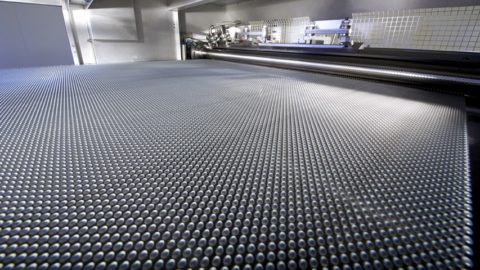-
 Case study of IPCO: Comprehensive improvement at Sanvik Shanghai factory (Part 1)
IPCO (THE INDUSTRIAL PROCESS SOLUTIONS COMPANY) is a world-renowned provider of quality improvement tools and solutions. Products and support services of IPCO are currently present in all continents and trusted by many businesses, such as: Automatic transmission lines, bearings, bearings, guide rollers, probes next to the belt, etc. With extensive experience...
Case study of IPCO: Comprehensive improvement at Sanvik Shanghai factory (Part 1)
IPCO (THE INDUSTRIAL PROCESS SOLUTIONS COMPANY) is a world-renowned provider of quality improvement tools and solutions. Products and support services of IPCO are currently present in all continents and trusted by many businesses, such as: Automatic transmission lines, bearings, bearings, guide rollers, probes next to the belt, etc. With extensive experience...
-
 Smart business model: New opportunities for businesses (Part 2)
The manufacturing industry is increasingly affected by the development trend of technology. Organizations are looking for tools to give them an edge over competitors, data-driven systems are gradually replacing traditional management systems, and more and more manufacturing businesses are taking steps. There is a great need for data usage, but they...
Smart business model: New opportunities for businesses (Part 2)
The manufacturing industry is increasingly affected by the development trend of technology. Organizations are looking for tools to give them an edge over competitors, data-driven systems are gradually replacing traditional management systems, and more and more manufacturing businesses are taking steps. There is a great need for data usage, but they...
-
 Application of 4.0 technology in the JIT production system (Part 2)
For investment companies that are adopting a pull production process (JIT), resource allocation must be carefully prepared based on work flow, order of execution, as well as customer requirements. The autonomous robot system (AMR) is also a resource worth considering, as it is replacing workers’ role in the manufacturing process. In...
Application of 4.0 technology in the JIT production system (Part 2)
For investment companies that are adopting a pull production process (JIT), resource allocation must be carefully prepared based on work flow, order of execution, as well as customer requirements. The autonomous robot system (AMR) is also a resource worth considering, as it is replacing workers’ role in the manufacturing process. In...
-
 Smart business model: New opportunities for businesses (Part 1)
The unpredictability in production and business activities is a major barrier for businesses that are initially applying 4.0 technology to production and business, especially businesses in the process of digital transformation. To solve this problem, many organizations have been striving to remove cost constraints to reach a higher level of profits,...
Smart business model: New opportunities for businesses (Part 1)
The unpredictability in production and business activities is a major barrier for businesses that are initially applying 4.0 technology to production and business, especially businesses in the process of digital transformation. To solve this problem, many organizations have been striving to remove cost constraints to reach a higher level of profits,...
-
 Improve business efficiency through quality functions (Part 2)
As mentioned in the previous section, QFD’s goal is to bring customers products that are not only high quality but also suitable for their needs and tastes. QFD helps to effectively communicate customer needs to a wide range of activities across the organization from design, production, quality control to marketing and...
Improve business efficiency through quality functions (Part 2)
As mentioned in the previous section, QFD’s goal is to bring customers products that are not only high quality but also suitable for their needs and tastes. QFD helps to effectively communicate customer needs to a wide range of activities across the organization from design, production, quality control to marketing and...
-
 Improving production efficiency thanks to quality functions (Part 1)
Consumers today have a multitude of options for similar products or services. In order to improve competitiveness, organizations need to constantly improve the quality of products and services as well as pay more attention to the needs of customers. Finding out the needs of customers in general is not easy. Organizations...
Improving production efficiency thanks to quality functions (Part 1)
Consumers today have a multitude of options for similar products or services. In order to improve competitiveness, organizations need to constantly improve the quality of products and services as well as pay more attention to the needs of customers. Finding out the needs of customers in general is not easy. Organizations...
-
 Digital Transformation Tools for Small and Medium Businesses (Part 2)
Today, digital conversion is becoming easier than ever, especially with the help of many free online tools such as Email, Hangout or some online databases like Dropbox, Google driver… These tools are cross-platform and can bring great potential for improvement if properly utilized. Project management support Trello: This is a job...
Digital Transformation Tools for Small and Medium Businesses (Part 2)
Today, digital conversion is becoming easier than ever, especially with the help of many free online tools such as Email, Hangout or some online databases like Dropbox, Google driver… These tools are cross-platform and can bring great potential for improvement if properly utilized. Project management support Trello: This is a job...
-
 Digital Transformation Tools for Small and Medium Businesses (Part 1)
Most of the managers of SMEs surveyed acknowledged that they needed digital transformation, but the process was often delayed due to lack of funding and relatively large workload. In many cases, the time spent on manually backing up data such as typing or recording books is more expensive for managers than...
Digital Transformation Tools for Small and Medium Businesses (Part 1)
Most of the managers of SMEs surveyed acknowledged that they needed digital transformation, but the process was often delayed due to lack of funding and relatively large workload. In many cases, the time spent on manually backing up data such as typing or recording books is more expensive for managers than...
-
 Aggregate factor productivity: A measure of the efficiency for managers (Part 2)
A Science Direct study shows that microscopic, synthetic factor productivity (TFP) may not be proportional to labor productivity (LP). To use TFP parameters appropriately, business managers need to dig deep into the relationship of factors affecting productivity. The above study considers overall factor productivity and labor productivity as different supporting factors...
Aggregate factor productivity: A measure of the efficiency for managers (Part 2)
A Science Direct study shows that microscopic, synthetic factor productivity (TFP) may not be proportional to labor productivity (LP). To use TFP parameters appropriately, business managers need to dig deep into the relationship of factors affecting productivity. The above study considers overall factor productivity and labor productivity as different supporting factors...
-
 Total Factor Productivity: A measure of efficiency for managers (Part 1)
Total Factor Productivity (TFP) is an economic term that shows the index of the results of production brought about by improving the efficiency of capital and labor, thanks to the impact of factors. innovating technology, rationalizing production, improving management, improving labor skillse… This production result can be divided into three parts:...
Total Factor Productivity: A measure of efficiency for managers (Part 1)
Total Factor Productivity (TFP) is an economic term that shows the index of the results of production brought about by improving the efficiency of capital and labor, thanks to the impact of factors. innovating technology, rationalizing production, improving management, improving labor skillse… This production result can be divided into three parts:...
Scroll
 Case study of IPCO: Comprehensive improvement at Sanvik Shanghai factory (Part 1)
IPCO (THE INDUSTRIAL PROCESS SOLUTIONS COMPANY) is a world-renowned provider of quality improvement tools and solutions. Products and support services of IPCO are currently present in all continents and trusted by many businesses, such as: Automatic transmission lines, bearings, bearings, guide rollers, probes next to the belt, etc. With extensive experience...
Case study of IPCO: Comprehensive improvement at Sanvik Shanghai factory (Part 1)
IPCO (THE INDUSTRIAL PROCESS SOLUTIONS COMPANY) is a world-renowned provider of quality improvement tools and solutions. Products and support services of IPCO are currently present in all continents and trusted by many businesses, such as: Automatic transmission lines, bearings, bearings, guide rollers, probes next to the belt, etc. With extensive experience...
 Smart business model: New opportunities for businesses (Part 2)
The manufacturing industry is increasingly affected by the development trend of technology. Organizations are looking for tools to give them an edge over competitors, data-driven systems are gradually replacing traditional management systems, and more and more manufacturing businesses are taking steps. There is a great need for data usage, but they...
Smart business model: New opportunities for businesses (Part 2)
The manufacturing industry is increasingly affected by the development trend of technology. Organizations are looking for tools to give them an edge over competitors, data-driven systems are gradually replacing traditional management systems, and more and more manufacturing businesses are taking steps. There is a great need for data usage, but they...
 Application of 4.0 technology in the JIT production system (Part 2)
For investment companies that are adopting a pull production process (JIT), resource allocation must be carefully prepared based on work flow, order of execution, as well as customer requirements. The autonomous robot system (AMR) is also a resource worth considering, as it is replacing workers’ role in the manufacturing process. In...
Application of 4.0 technology in the JIT production system (Part 2)
For investment companies that are adopting a pull production process (JIT), resource allocation must be carefully prepared based on work flow, order of execution, as well as customer requirements. The autonomous robot system (AMR) is also a resource worth considering, as it is replacing workers’ role in the manufacturing process. In...
 Smart business model: New opportunities for businesses (Part 1)
The unpredictability in production and business activities is a major barrier for businesses that are initially applying 4.0 technology to production and business, especially businesses in the process of digital transformation. To solve this problem, many organizations have been striving to remove cost constraints to reach a higher level of profits,...
Smart business model: New opportunities for businesses (Part 1)
The unpredictability in production and business activities is a major barrier for businesses that are initially applying 4.0 technology to production and business, especially businesses in the process of digital transformation. To solve this problem, many organizations have been striving to remove cost constraints to reach a higher level of profits,...
 Improve business efficiency through quality functions (Part 2)
As mentioned in the previous section, QFD’s goal is to bring customers products that are not only high quality but also suitable for their needs and tastes. QFD helps to effectively communicate customer needs to a wide range of activities across the organization from design, production, quality control to marketing and...
Improve business efficiency through quality functions (Part 2)
As mentioned in the previous section, QFD’s goal is to bring customers products that are not only high quality but also suitable for their needs and tastes. QFD helps to effectively communicate customer needs to a wide range of activities across the organization from design, production, quality control to marketing and...
 Improving production efficiency thanks to quality functions (Part 1)
Consumers today have a multitude of options for similar products or services. In order to improve competitiveness, organizations need to constantly improve the quality of products and services as well as pay more attention to the needs of customers. Finding out the needs of customers in general is not easy. Organizations...
Improving production efficiency thanks to quality functions (Part 1)
Consumers today have a multitude of options for similar products or services. In order to improve competitiveness, organizations need to constantly improve the quality of products and services as well as pay more attention to the needs of customers. Finding out the needs of customers in general is not easy. Organizations...
 Digital Transformation Tools for Small and Medium Businesses (Part 2)
Today, digital conversion is becoming easier than ever, especially with the help of many free online tools such as Email, Hangout or some online databases like Dropbox, Google driver… These tools are cross-platform and can bring great potential for improvement if properly utilized. Project management support Trello: This is a job...
Digital Transformation Tools for Small and Medium Businesses (Part 2)
Today, digital conversion is becoming easier than ever, especially with the help of many free online tools such as Email, Hangout or some online databases like Dropbox, Google driver… These tools are cross-platform and can bring great potential for improvement if properly utilized. Project management support Trello: This is a job...
 Digital Transformation Tools for Small and Medium Businesses (Part 1)
Most of the managers of SMEs surveyed acknowledged that they needed digital transformation, but the process was often delayed due to lack of funding and relatively large workload. In many cases, the time spent on manually backing up data such as typing or recording books is more expensive for managers than...
Digital Transformation Tools for Small and Medium Businesses (Part 1)
Most of the managers of SMEs surveyed acknowledged that they needed digital transformation, but the process was often delayed due to lack of funding and relatively large workload. In many cases, the time spent on manually backing up data such as typing or recording books is more expensive for managers than...
 Aggregate factor productivity: A measure of the efficiency for managers (Part 2)
A Science Direct study shows that microscopic, synthetic factor productivity (TFP) may not be proportional to labor productivity (LP). To use TFP parameters appropriately, business managers need to dig deep into the relationship of factors affecting productivity. The above study considers overall factor productivity and labor productivity as different supporting factors...
Aggregate factor productivity: A measure of the efficiency for managers (Part 2)
A Science Direct study shows that microscopic, synthetic factor productivity (TFP) may not be proportional to labor productivity (LP). To use TFP parameters appropriately, business managers need to dig deep into the relationship of factors affecting productivity. The above study considers overall factor productivity and labor productivity as different supporting factors...
 Total Factor Productivity: A measure of efficiency for managers (Part 1)
Total Factor Productivity (TFP) is an economic term that shows the index of the results of production brought about by improving the efficiency of capital and labor, thanks to the impact of factors. innovating technology, rationalizing production, improving management, improving labor skillse… This production result can be divided into three parts:...
Total Factor Productivity: A measure of efficiency for managers (Part 1)
Total Factor Productivity (TFP) is an economic term that shows the index of the results of production brought about by improving the efficiency of capital and labor, thanks to the impact of factors. innovating technology, rationalizing production, improving management, improving labor skillse… This production result can be divided into three parts:...